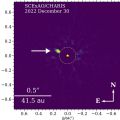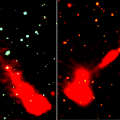Théorie de la fonctionnelle de la densité - Définition
Source: Wikipédia sous licence CC-BY-SA 3.0.
La liste des auteurs de cet article est disponible ici.
La liste des auteurs de cet article est disponible ici.
Logiciels implémentant la DFT
|
|
voir mise à jour : "List of quantum chemistry and solid state physics software"
Notes et références
- (en) P.A.M. Dirac, « Quantum Mechanics of Many-Electron Systems », dans Proceedings of the Royal Society of London. Series A, Containing Papers of a Mathematical and Physical Character, vol. 123, no 792, 1929, p. 714-733 : The underlying physical laws necessary for the mathematical theory of a large part of physics and the whole of chemistry are thus completely known,and the difficulty is only that the exact application of these laws leads to equations much too complicated to be soluble.
- (en) E. Schrödinger, « An Undulatory Theory of the Mechanics of Atoms and Molecules », dans Phys. Rev., vol. 28, 1926, p. 1049-1070
- (fr)Il s'agit ici de l'équation de Schrödinger indépendante du temps.
- (de) M. Born et R. Oppenheimer, « Zur Quantentheorie der Molekeln », dans Annealen der Phyzik, vol. 389, 1927, p. 457-484
- (fr)La masse d'un nucléon est environ 1837 fois plus grande que la masse d'un électron
- (fr)Suite à l'approximation de Born-Oppenheimer, le hamiltonien total peut être séparé en un hamiltonien nucléaire et un hamiltonien électronique. Les propriétés des matériaux étant essentiellement caractérisées par le comportement des électrons, le hamiltonien décrit dans la suite de cet article sera toujours l'hamiltonien électronique.
- (fr) Par convention, la densité électronique est symbolisée par n(r) dans cet article. Il est cependant courant de la trouver symbolisée par ρ(r) dans de nombreux ouvrages et publications.
- (en) L.H. Thomas, « The calculation of atomic field », dans Proc. Cambridge Phil. Roy. Soc., vol. 23, 1927, p. 542-548
- (it) E. fermi, « Un metodo statistico per la determinazione di alcune priorieta dell'atome », dans Rend. Accad. Naz. Lincei, vol. 6, 1927, p. 602-607
- (en) Robert G. Parr et Weitao Yang, op. cit., 47
- (en) Norman H. March, op. cit, p. 24
- (en) P.A.M. Dirac, « Note on exchange phenomena in the Thomas-Fermi atom », dans Proc. Cambridge Phil. Roy. Soc., vol. 26, 1930, p. 376-385
- (de) C.F. von Weizsacker, « Zur Theorie der Kernmassen », dans Z. Phys., vol. 96, 1935, p. 431
- (en) R.P. Feynman, N. Metropolis et E. Teller, « Equations of state of elements based on the Thomas-Fermi theory », dans Phys. Rev., vol. 75, 1949, p. 1561-1573
- (en) E. Teller, « On the stability of molecules in the Thomas-Fermi theory », dans Rev. Mod. Phys., vol. 34, 1962, p. 627-630
- (en) P. Hohenberg et W. Kohn, « Inhomogenous Electron Gas », dans Phys. Rev., vol. 136, 1964, p. B864-B871
- (en) Richard L. Martin, op. cit. p. 135 : If you don't like the answer, change the question
- (en) W. Khon, et L.J. Sham, « Self-Consistent Equations Including Exchange and Correlation Effects », dans Phys. Rev., vol. 140, 1965, p. A1133-A1138
- (en) Klaus Capelle, « A bird's-eye view of density-functional theory. », dans Braz. J. Phys., vol. 36, no 4A, 2006, p. 1318-1343
- (fr) Contrairement à l'équation de Schrödinger, les valeurs propres des équations de Kohn-Sham ne représentent pas à proprement parler l'énergie.
- (fr) Bien qu'il soit commun de séparer ainsi l'échange et la corrélation, il existe néanmoins quelques doutes sur la légitimité de cette séparation.
- (en) Richard L. Martin, op. cit., p 120
- (en) J. C. Slater, « Simplification of the Hartree-Fock Method », dans Phys. Rev., vol. 81, 1951, p. 385-390
- (fr) Dans le cas de systèmes électroniques à couches fermées, la densité électronique des spin up et down sont égales et les approches LDA et LSDA deviennent identiques
- (en) D. Ceperley, « Ground state of the fermion one-component plasma: A Monte Carlo study in two and three dimensions », dans Phys. Rev. B, vol. 18, 1978, p. 3126-3138
- (en) D.M. Ceperley et B.J. Alder, « Ground State of the Electron Gas by a Stochastic Method », dans Phys. Rev. Lett., vol. 45, 1980, p. 566-569
- (en) R.L. Martin, op. cit. p. 479
- (en) J. P. Perdew and A. Zunger, « Self-interaction correction to density-functional approximations for many-electron systems », dans Phys. Rev. B, vol. 23, 1981, p. 5048-5079
- (en) S. H. Vosko, L. Wilk et M. Nusair, « Accurate spin-dependent electron liquid correlation energies for local spin density calculations: a critical analysis », dans Can. J. Phys, vol. 58, 1980, p. 1200-1211
- (en)Richard L. Martin, op. cit., p.479
- (en)Richard L. Martin, op. cit., p. 100
- (en)Richard L. Martin, op. cit., p. 479-480
- (en) Ref nécessaire : LSD is thus a first-principle approximation, in the sens that its parameters are not fitted empirically to calculated or experimentals results other than one in which its form is exact
- (en) A. D. Becke, « Density-functional exchange-energy approximation with correct asymptotic behavior », dans Phys. Rev. A, vol. 38, 1988, p. 3098
- (en) J.P. Perdew, K. Burke et Y. Wang, « Generalized gradient approximation for the exchange-correlation hole of a many-electron system », dans Phys. Rev . B, vol. 54, 1996, p. 16533-16539
- (en) C. Adamo et V. Barone, « Exchange functionals with improved long-range behavior and adiabatic connection methods without adjustable parameters: The mPW and mPW1PW models », dans J. Chem. Phys., vol. 108, 1998, p. 664
- (en) A.D. Becke, « Density-functional exchange-energy approximation with correct asymptotic behavior », dans Phys. Rev. A, vol. 38, 1988, p. 3098-3100
- (en) J.P. Perdew et Y. Wang, « Accurate and simple density functional for the electronic exchange energy: Generalized gradient approximation », dans Phys. Rev. B, vol. 33, 1986, p. 8800-8802
- (en) J.P. Perdew, K. Burke, et M Ernzerhof, « Generalized Gradient Approximation Made Simple », dans Phys. Rev. Lett., vol. 77, 1996, p. 3865-3868
- (en) Richard L. Martin op. cit. p 154-155
- (en) A.D. Becke, « Density-functional thermochemistry. IV. A new dynamical correlation functional and implications for exact-exchange mixing », dans J. Chem. Phys., vol. 104, 1996, p. 1040
- (fr) Ce choix est fondé sur le fait que l'échange électronique est décrit de manière exacte dans la théorie Hartree-Fock
- (en) S.F. Sousa, P.A. Fernandes et M.J. Ramos, « General Performance of Density Functionals », dans J. Phys. Chem. A, vol. 111, 2007, p. 10439-10452
- (en) (en) J.P. Perdew, K. Schmidt, Density Functional Theory and Its Application to Materials, V. Van Doren , C. Van Alsenoy , P. Geerlings, 1er août 2001, 220 p.

















































